A crop walk at Seedtech’s trial site last week (Tuesday 5 March, when pictures were taken) was refreshing. Yes, ground was wet and crops didn’t look hectic, but when you look a little bit closer they’re not all that bad.
One advantage of the walk was that we could view different seeding rates and crops which looked very poor actually had viable plants stands.
Different sowing dates were also on show and given the year that’s in it you would be very happy with the winter barley planted on 9 October. It was patchy in spots, but looked well where it was growing. Some two-row varieties were yellowing and suffering from disease in spots.
It was in bad need of fertiliser. Ground conditions have halted travel up to now. Since our visit, 1.5 bags/ac of Sulcan were spread on Friday 8 March and a compound of 10-8-21 will be applied in mid-March or GS30.
The 2 December-sown Orcade winter barley looked a picture (see below). It was even and consistent, while obviously not as far on as the October-sown crop.
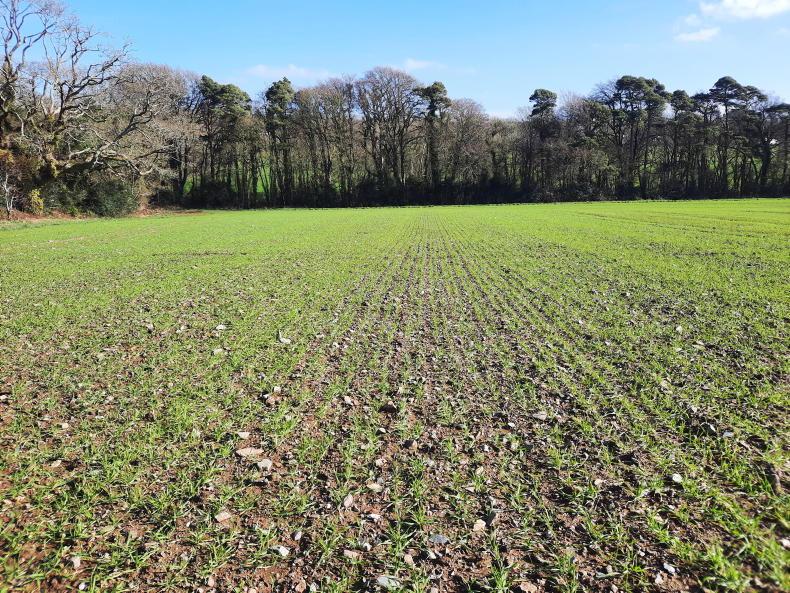
Orcade winter barley planted on 2 December 2023.
Winter rye was struggling. It was planted after oilseed rape on 16 October, which is late for rye.
There is a mix of very good and bad rye crops out there, which Tim thinks is down to local weather conditions. He said rye needs a clear window after sowing and it’s not all about drilling date. It’s more about weather after drilling.
It was going to get 1.5 bags/ac of Sulcan at the end of last week. It was due CeCeCe approximately a week after this. Tim O’Donovan, technical director at Seedtech, commented that the first application of growth regulator on rye is important to ensure the base of the stem is strong enough to support the crop.
Rainfall is measured on site. To give an idea of the hardship crops have endured, the winter barley, wheat and rye all received 650mm of rain since planting. The trial site received 250mm of rain since 1 January to last week.
Looking at different seeding rates
Seedtech puts the optimum seed rate for hybrid barley and rye at 200 seeds/m2 at the end of September until mid-October.
Seed rate will be calculated using the target plant count, the estimated establishment percentage and the thousand grain weight.
Belfry hybrid winter barley was planted at 200 seeds/m2 (100kg/ha or 6.4st/ac).
On 5 March, there were 675 shoots/m2 in this plot. Interestingly, where Belfry was planted at 150 seeds/m2 (75kg/ha or 4.8st/ac) there were 760 shoots/m2.
KWS Joyau winter barley planted at 300 seeds/m2 (147kg/ha or 9.4st/ac) had 650 shoots/m2.
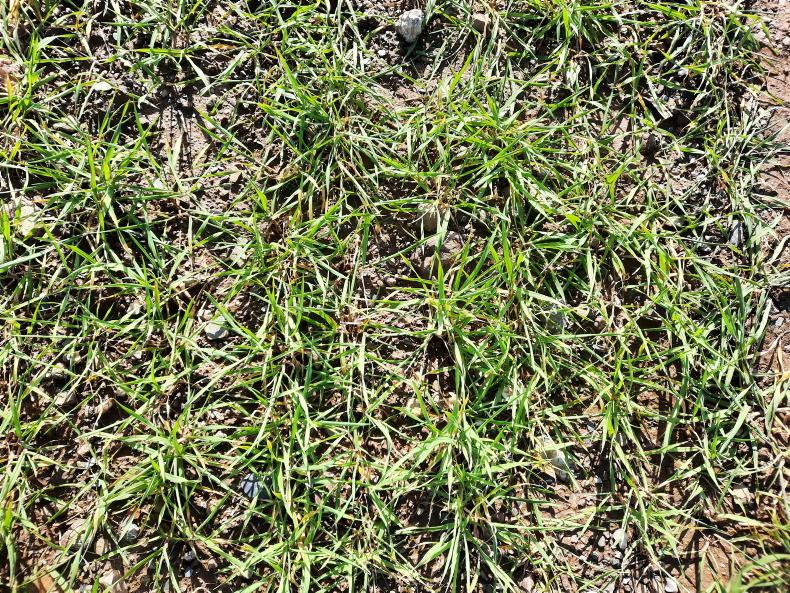
Joyau at 300 seed/m2.
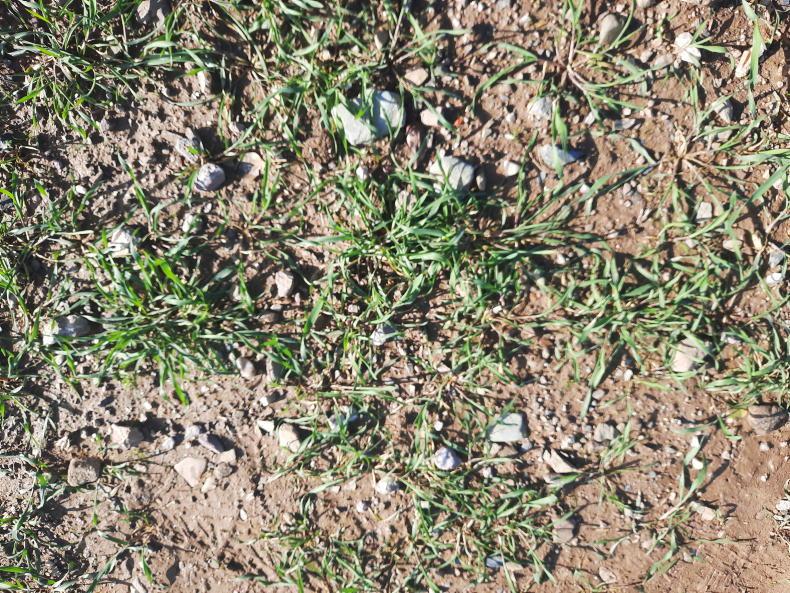
KWS Tayo at 150 seed m2.
KWS Tayo winter rye planted at 150 seeds/m2 (60kg/ha or 3.8st/ac) had 580 shoots/m2 (not a plant count, so this includes all tillers), while the Tayo planted at 250 seeds/m2 was slightly denser. Tim commented that once there are 500 to 600 shoots/m2 in March, the crop can achieve 90% of the potential yield which is about 4.5t/ac.
In the trial plots, Laureate spring barley had been planted in December. This season is not one where spring malting barley has been planted early, but in drier years a number of farmers often move early with their spring barley on drier land to keep protein contents down.
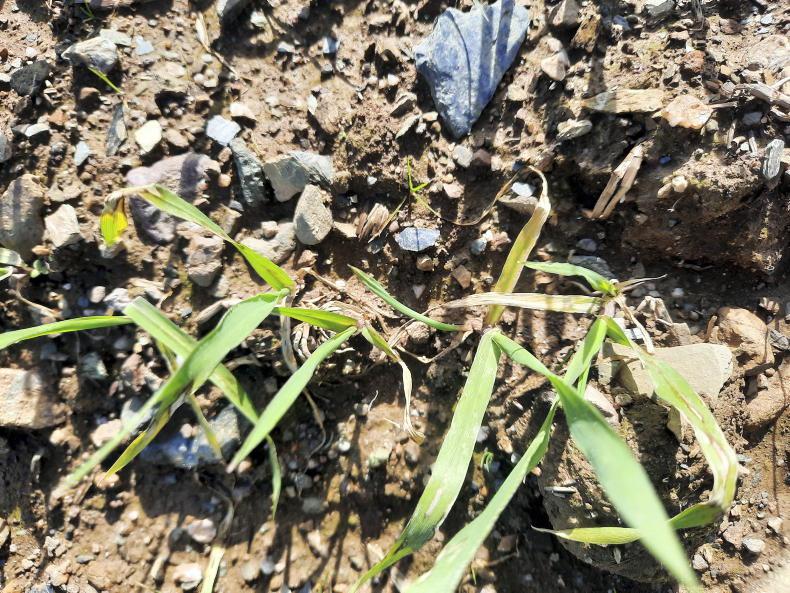
Rhynchosporium on Laureate spring barley sown on 2 December 2023. Photo taken on 5 March 2024.
The crop was thin, as was to be expected. It was planted for trial purposes. It had bad rhynchosporium infection due to its early sowing date and rain since then.
The oilseed rape we looked at was very advanced. It was planted on 7 September, but had been covered with a fleece for a trial on the site, so it was not your usual crop of oilseed rape.
The variety was LG Academic and no light leaf spot was found in the crop. Trial site manager Denis Dunne had taken leaf samples and placed them in a plastic bag. However, a fungicide is still necessary to keep the disease at bay and avoid damage to stems and pods later on in the season.
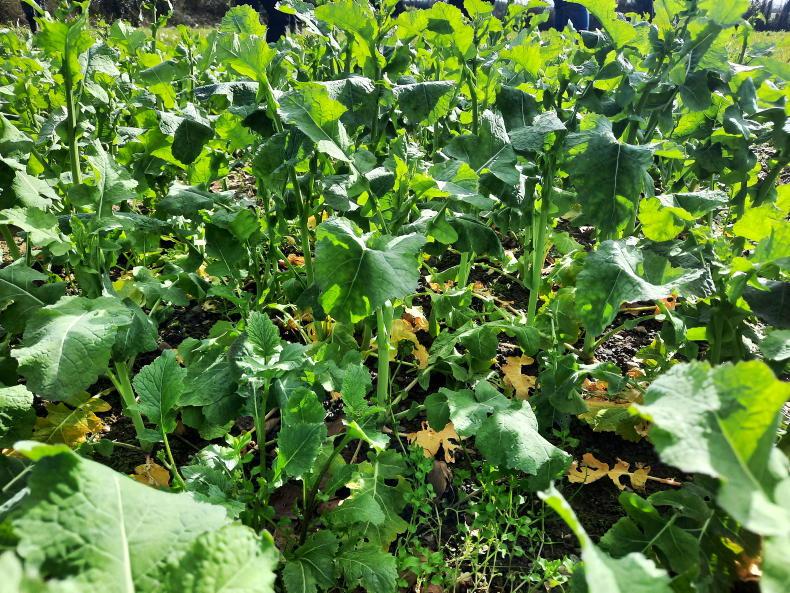
A dense crop of oilseed rape which needs a plant growth regulator.
With a green area index (GAI), well ahead of most crops at 3, Tim was happy with the crop. GAI is a big help in deciding what nitrogen rate to apply.
The more green area in the crop, the more nitrogen it has already taken up.
He said that in February 2023, Seedtech examined crops from Cork to Louth for GAI and there was an average saving of 68kg N/ha versus the standard rate on those crops with no impact on yield.
While the advice was to plant 50 to 70 seeds/m2 to achieve 25 to 35 plants/m2, different seed rates had been examined at 20, 30, 40, 50, 60 and 70 seeds/m2. There was a respectable crop where 20 seeds/m2 had been planted and Tim noted that where there are 10 plants/m2, or so, you can still get a respectable yield of 1.5t/ac to 1.7t/ac.
There was even emergence on the crops planted at lower seed rates and light was able to get to plants to help with branching.
Denser crops will struggle to branch lower down on the stem and will benefit from a growth regulator as can be seen in the image above.
The main winter wheat crop was planted after oilseed rape and received 650mm of rain since planting up to last week. It had received its herbicide – Firebird Met. An insecticide was applied at the same time on 11 December.
This week, or in the coming days, it will receive 4 bags/ac of 10-8-21 when the crop hits GS30. CeCeCe and Moddus or Medax Max will also be applied around this time.
A T0 fungicide may be applied, but will be assessed nearer to the time. December-sown wheat will not receive a T0.
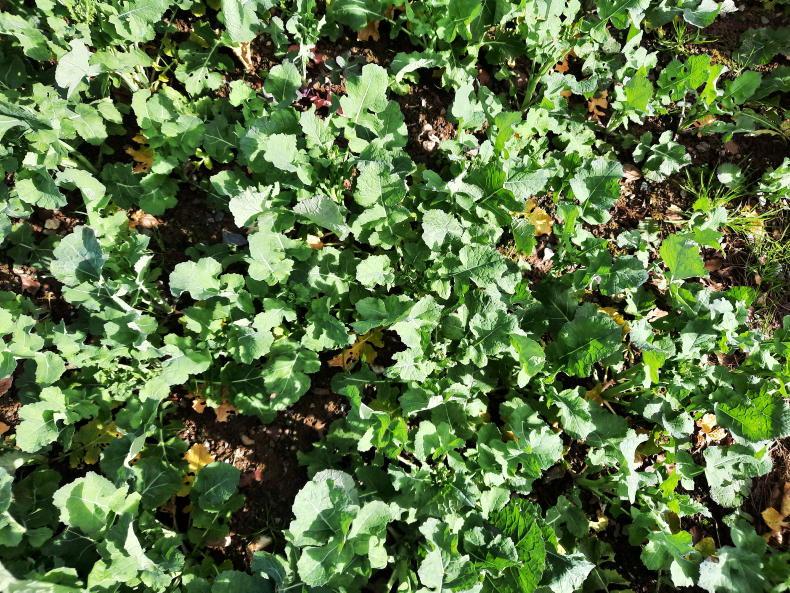
LG Academic GAI 3.
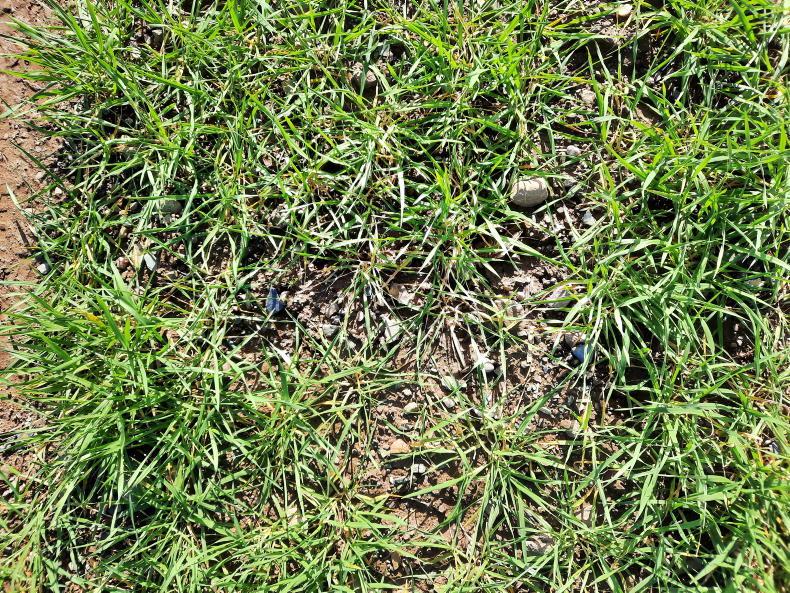
Belfry 150 seeds/m2.
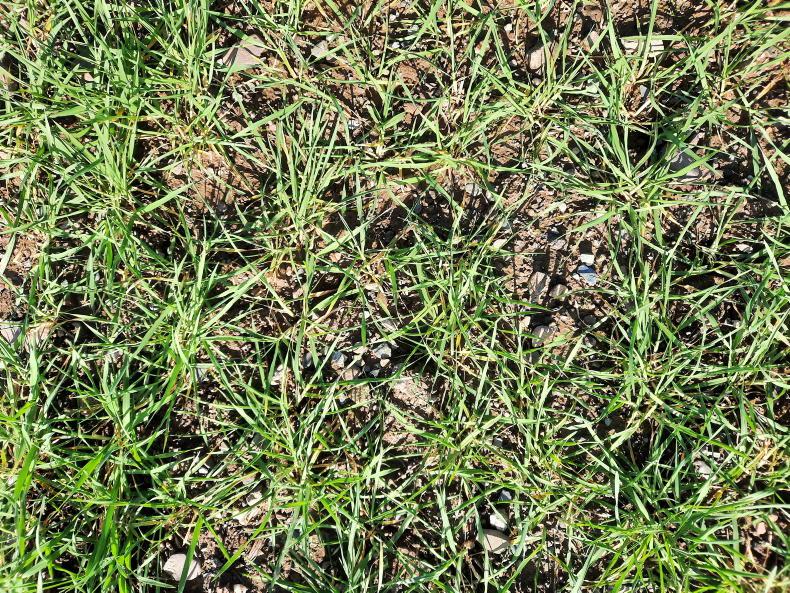
Belfry at 200 seeds/m2.
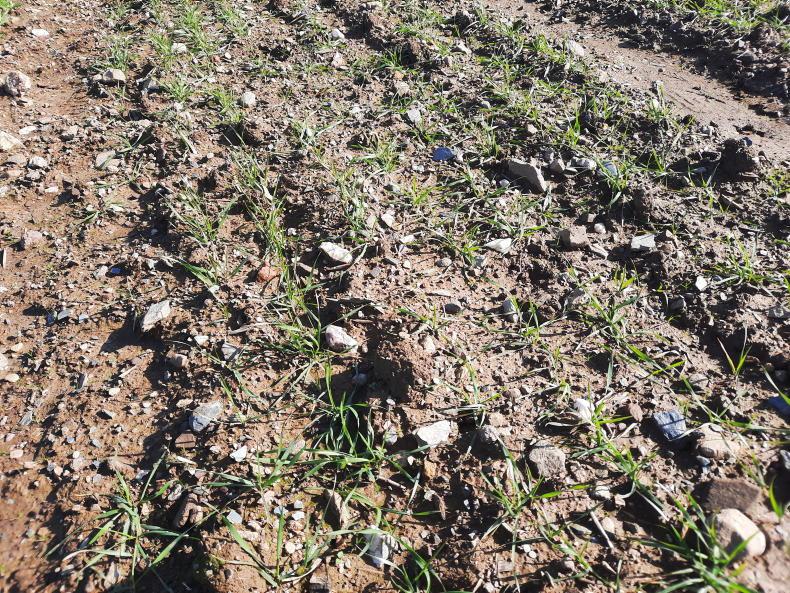
Graham-sown 2 December 2023. The picture was taken on 5 March 2024.
A crop walk at Seedtech’s trial site last week (Tuesday 5 March, when pictures were taken) was refreshing. Yes, ground was wet and crops didn’t look hectic, but when you look a little bit closer they’re not all that bad.
One advantage of the walk was that we could view different seeding rates and crops which looked very poor actually had viable plants stands.
Different sowing dates were also on show and given the year that’s in it you would be very happy with the winter barley planted on 9 October. It was patchy in spots, but looked well where it was growing. Some two-row varieties were yellowing and suffering from disease in spots.
It was in bad need of fertiliser. Ground conditions have halted travel up to now. Since our visit, 1.5 bags/ac of Sulcan were spread on Friday 8 March and a compound of 10-8-21 will be applied in mid-March or GS30.
The 2 December-sown Orcade winter barley looked a picture (see below). It was even and consistent, while obviously not as far on as the October-sown crop.

Orcade winter barley planted on 2 December 2023.
Winter rye was struggling. It was planted after oilseed rape on 16 October, which is late for rye.
There is a mix of very good and bad rye crops out there, which Tim thinks is down to local weather conditions. He said rye needs a clear window after sowing and it’s not all about drilling date. It’s more about weather after drilling.
It was going to get 1.5 bags/ac of Sulcan at the end of last week. It was due CeCeCe approximately a week after this. Tim O’Donovan, technical director at Seedtech, commented that the first application of growth regulator on rye is important to ensure the base of the stem is strong enough to support the crop.
Rainfall is measured on site. To give an idea of the hardship crops have endured, the winter barley, wheat and rye all received 650mm of rain since planting. The trial site received 250mm of rain since 1 January to last week.
Looking at different seeding rates
Seedtech puts the optimum seed rate for hybrid barley and rye at 200 seeds/m2 at the end of September until mid-October.
Seed rate will be calculated using the target plant count, the estimated establishment percentage and the thousand grain weight.
Belfry hybrid winter barley was planted at 200 seeds/m2 (100kg/ha or 6.4st/ac).
On 5 March, there were 675 shoots/m2 in this plot. Interestingly, where Belfry was planted at 150 seeds/m2 (75kg/ha or 4.8st/ac) there were 760 shoots/m2.
KWS Joyau winter barley planted at 300 seeds/m2 (147kg/ha or 9.4st/ac) had 650 shoots/m2.

Joyau at 300 seed/m2.

KWS Tayo at 150 seed m2.
KWS Tayo winter rye planted at 150 seeds/m2 (60kg/ha or 3.8st/ac) had 580 shoots/m2 (not a plant count, so this includes all tillers), while the Tayo planted at 250 seeds/m2 was slightly denser. Tim commented that once there are 500 to 600 shoots/m2 in March, the crop can achieve 90% of the potential yield which is about 4.5t/ac.
In the trial plots, Laureate spring barley had been planted in December. This season is not one where spring malting barley has been planted early, but in drier years a number of farmers often move early with their spring barley on drier land to keep protein contents down.

Rhynchosporium on Laureate spring barley sown on 2 December 2023. Photo taken on 5 March 2024.
The crop was thin, as was to be expected. It was planted for trial purposes. It had bad rhynchosporium infection due to its early sowing date and rain since then.
The oilseed rape we looked at was very advanced. It was planted on 7 September, but had been covered with a fleece for a trial on the site, so it was not your usual crop of oilseed rape.
The variety was LG Academic and no light leaf spot was found in the crop. Trial site manager Denis Dunne had taken leaf samples and placed them in a plastic bag. However, a fungicide is still necessary to keep the disease at bay and avoid damage to stems and pods later on in the season.

A dense crop of oilseed rape which needs a plant growth regulator.
With a green area index (GAI), well ahead of most crops at 3, Tim was happy with the crop. GAI is a big help in deciding what nitrogen rate to apply.
The more green area in the crop, the more nitrogen it has already taken up.
He said that in February 2023, Seedtech examined crops from Cork to Louth for GAI and there was an average saving of 68kg N/ha versus the standard rate on those crops with no impact on yield.
While the advice was to plant 50 to 70 seeds/m2 to achieve 25 to 35 plants/m2, different seed rates had been examined at 20, 30, 40, 50, 60 and 70 seeds/m2. There was a respectable crop where 20 seeds/m2 had been planted and Tim noted that where there are 10 plants/m2, or so, you can still get a respectable yield of 1.5t/ac to 1.7t/ac.
There was even emergence on the crops planted at lower seed rates and light was able to get to plants to help with branching.
Denser crops will struggle to branch lower down on the stem and will benefit from a growth regulator as can be seen in the image above.
The main winter wheat crop was planted after oilseed rape and received 650mm of rain since planting up to last week. It had received its herbicide – Firebird Met. An insecticide was applied at the same time on 11 December.
This week, or in the coming days, it will receive 4 bags/ac of 10-8-21 when the crop hits GS30. CeCeCe and Moddus or Medax Max will also be applied around this time.
A T0 fungicide may be applied, but will be assessed nearer to the time. December-sown wheat will not receive a T0.

LG Academic GAI 3.

Belfry 150 seeds/m2.

Belfry at 200 seeds/m2.

Graham-sown 2 December 2023. The picture was taken on 5 March 2024.















 This is a subscriber-only article
This is a subscriber-only article








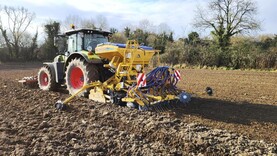

SHARING OPTIONS: